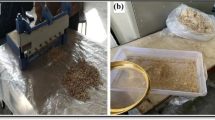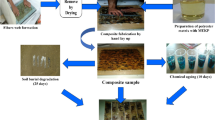Abstract
In this study, the biodegradability, morphology, mechanical, and thermal properties of composite materials composed of polybutyleneterephthalate (PBT), acrylic acid-grafted PBT (PBT-g-AA), and sisal fibers (SFs) were evaluated. Composites containing acrylic acid-grafted PBT (PBT-g-AA/SF) exhibited superior mechanical properties because of their greater compatibility with SF than PBT/SF. The dispersion of SF in the PBT-g-AA matrix was highly homogeneous due to ester formation and the creation of branched and cross-linked macromolecules between the carboxyl groups of PBT-g-AA and the hydroxyl groups of SF. Furthermore, due to its lower melting temperature (T m), the PBT-g-AA/SF composite was more readily synthesized. Each composite was subjected to biodegradation tests in a soil environment. Both the PBT and PBT-g-AA/SF composite films were completely degraded, with severe disruption of the film structures observed after 60–100 days of incubation. Although the degree of weight loss following burial indicated that both materials were biodegradable, even with high levels of SF loading, the higher water resistance of PBT-g-AA/SF films indicated their higher biodegradability than the PBT films.










Similar content being viewed by others
References
Satyanarayana KG, Arizaga GGC, Wypych F (2009) Biodegradable composites based on lignocellulosic fibers—an overview. Prog Polym Sci 34:982–1021
Steinbüchel A (2005) Non-biodegradable biopolymers from renewable resources: perspectives and impacts. Curr Opin Biotechnol 16:607–613
Yu L, Dean K, Li L (2006) Polymer blends and composites from renewable resources. Prog Polym Sci 31:576–602
Tripathy AR, Chenl W, Kukureka SN, MacKnight WJ (2003) Novel poly(butylene terephthalate)/poly(vinyl butyral) blends prepared by in situ polymerization of cyclic poly(butylene terephthalate) oligomers. Polymer 44:1835–1842
Xiao J, Hu Y, Yang L, Cai Y, Song L, Chen Z, Fan W (2006) Fire retardant synergism between melamine and triphenyl phosphate in poly(butylene terephthalate). Polym Degrad Stab 91:2093–2100
Loua CW, Lin CW, Lei CH, Su KH, Hsu CH, Liu ZH, Lin JH (2007) PET/PP blend with bamboo charcoal to produce functional composites. J Mater Process Technol 192–193:428–433
Kunanopparat T, Menut P, Morel MH, Guilbert S (2008) Reinforcement of plasticized wheat gluten with natural fibers: from mechanical improvement to deplasticizing effect. Composites A 39:777–785
Chow CPL, Xing XS, Li RKY (2007) Moisture absorption studies of sisal fibre reinforced polypropylene composites. Compos Sci Technol 67:306–313
Velde KV, Kiekens P (2001) Thermoplastic pultrusion of natural fibre reinforced composites. Compos Struct 54:355–360
Lei Y, Wu Q, Yao F, Xu Y (2007) Preparation and properties of recycled HDPE/natural fiber composites. Composites A 38:1664–1674
Coulembiera O, Dege’ee P, Hedrickb JL, Dubois P (2006) From controlled ring-opening polymerization to biodegradable aliphatic polyester: especially poly(β-malic acid) derivatives. Prog Polym Sci 31:723–747
Liang D, Hsiao BS, Chu B (2007) Functional electrospun nanofibrous scaffolds for biomedical applications. Adv Drug Deliv Rev 59:1392–1412
Ríhová B (1996) Biocompatibility of biomaterials: hemocompatibility, immunocompatiblity and biocompatibility of solid polymeric materials and soluble targetable polymeric carriers. Adv Drug Deliv Rev 21:157–176
Wu CS (2005) Improving polylactide/starch biocomposites by grafting polylactide with acrylic acid—characterization and biodegradability assessment. Macromol Biosci 5:352–361
Alvarez VA, Ruseckaite RA, Va′zquez A (2006) Degradation of sisal fibre/Mater Bi-Y biocomposites buried in soil. Polym Degrad Stab 91:3156–3162
Su WY, Wang Y, Min K, Quirk RP (2001) In situ copolymerization and compatibilization of polyester and polystyrene blends. I. Synthesis of functionalized polystyrenes and the reactions with polyester. Polymer 42:5107–5119
Wu CS (2008) Evaluation of polybutylene succinate (PBSU)/starch and PBSU-g-AA/starch composites as capsule material for controlled release of phosphate-solubilizing Bacillus fertilizer. J Control Release 132:42–48
Shah BL, Selke SE, Walters MB, Heiden PA (2008) Effects of wood flour and chitosan on mechanical, chemical, and thermal properties of polylactide. Polym Compos 29:655–663
Jansen MAG, Goossens JGP, Wit G, Bailly C, Koning CE (2006) The microstructure of poly(butylene terephthalate) copolymers via 13C NMR sequence distribution analysis: Solid-state copolymerization versus melt copolymerization. Anal Chim Acta 557:19–30
Martins MA, Forato LA, Mattoso LHC, Colnago LA (2006) A solid state 13C high resolution NMR study of raw and chemically treated sisal fibers. Carbohydr Polym 64:127–133
Wu CS (2004) Analysis of mechanical, thermal, and morphological behavior of polycaprolactone/wood flour blends. J Appl Polym Sci 94:1000–1006
Raquez JM, Nabar Y, Narayan R, Dubois P (2008) Novel high-performance talc/poly[(butylene adipate)-co-terephthalate] hybrid materials. Macromol Mater Eng 293:310–320
Luyt AS, Malunka ME (2005) Composites of low-density polyethylene and short sisal fibres: the effect of wax addition and peroxide treatment on thermal properties. Thermochim Acta 426:101–107
Acknowledgments
The author thanks the National Science Council (Taipei City, Taiwan, R.O.C.) for financial support (NSC 99-2622-E-244-001-CC3).
Author information
Authors and Affiliations
Corresponding author
Rights and permissions
About this article
Cite this article
Wu, CS., Yen, FS. & Wang, CY. Polyester/natural fiber biocomposites: preparation, characterization, and biodegradability. Polym. Bull. 67, 1605–1619 (2011). https://doi.org/10.1007/s00289-011-0509-9
Received:
Revised:
Accepted:
Published:
Issue Date:
DOI: https://doi.org/10.1007/s00289-011-0509-9




